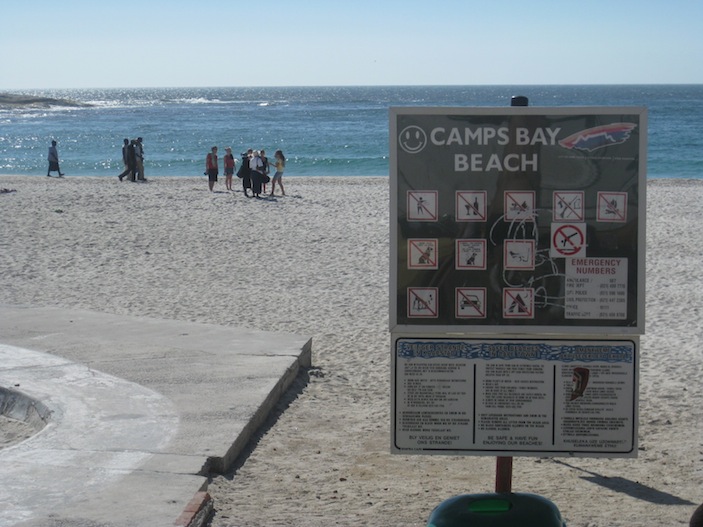Posts Tagged ‘IDcapetown’
IDcapetown: The Gum Boot Dance
You don’t need to spend too much time in tourist spots like Cape Town’s V&A Waterfront to witness a dance truly unique to South Africa—that of the gumboot. Originally conceived by black South African miners as an alternative to drumming, which was prohibited by authorities, the dance consists of a group of guys dressed in Wellington boots, often embellished with bells, stomping on the ground rhythmically.
Interestingly enough, the dance was originally intended to be a communication tool. Miners were not only prohibited from drumming—they were prohibited from talking altogether in some cases. Combine that with the dark, damp conditions in which they often had to work, and the sound of the stomping basically served as a code intended for someone nearby. As for the boots, they just happened to be what the miners wore, who often stood in knee-deep water while working.
An important part of South Africa’s cultural history, the gumboot dance is still seen frequently throughout the country, and also taught in some schools. While it certainly draws inspiration from other African dances featuring polyrhythm and body articulation, it is truly a South African art. Outside of the country, you can see traces of the gumboot dance’s influence in the step shows popularized by fraternities and sororities in the United States and beyond. But as nothing quite compares to the original, enjoy the video below!
IDcapetown: Camps Bay Beach
Apartheid was Right Here Less Than 20 Years Ago!
While South Africa put its best foot forward to embody the “Rainbow Nation” mantra that Nelson Mandela was heavily responsible for brilliantly engineering while it hosted the World Cup in 2010, it is virtually impossible to touch down in this country for the first time and not think about the fact that apartheid, and all its injustices and horrors, was right here less than 20 years ago. The “coloured” (mixed race) gate agent greeting you off the jet bridge lived through it. The white immigration officer who stamped your passport lived through it. The black taxi driver who whisks you off to your hotel lived through it. And not as a distant childhood memory, either. These men and women who you are interacting with ever so casually today actually lived a high percentage of their adult lives under apartheid.
As excited as I was to be landing in South Africa for the first time and as anxious as I was to lay eyes on Cape Town, I had a really difficult time wrapping my head around this. I wanted with every fiber of my being to ask the mixed woman what she felt of her ethnicity today, and if she still had any bitterness to either the blacks or whites, neither of which would have accepted her 20 years ago. I wanted to ask the white man if he himself was racist before, or merely a pawn in a political game he had no clout in. Or, for that matter, if he held any strong prejudices against blacks even today. I wanted to ask the black man his take on the current “equality”, and whether it was truly possible for anyone not named Mandela to endure racial oppression for so long and be willing to wipe the slate against your oppressors clean.
Such a gruesome and fascinating, albeit sensitive, topic, I will use this space in the future to dig into these questions.
Living In the Presence of HIV
Being from a developed Western country, HIV and AIDS has generated enough buzz over the past two decades—for me, since Magic Johnson revealed his infection—to become a reality we are well aware of. Still, it is understandably an extremely uncomfortable topic for most of us, and fortunately because of the education and preventive measures widely available, it has never exploded to the point where every one of us is close with someone who is infected.
Maybe that’s why I was shocked to learn that more than 10 percent of the South African population is HIV positive.
I had heard before about the problems that many African nations have had with AIDS. But my clouded vision imagined an epidemic that was only running through uneducated, disconnected rural tribes, lacking modern means of communication and modern societal infrastructures. But when you land in Johannesburg, it feels no different from landing in any populated and expansive city in America—with modern glass buildings, bustling expressways and neat housing sub-divisions all around. I guess it is this contrast from what I expected that really made me take notice.
Ten percent. Imagine that proportion in your workplace, or on your athletic teams. Imagine it in your apartment complex, or in your own extended family. And South Africa is a modern, middle-income, industrial society, with parts that don’t feel any different from Kansas or California. With the mere mention of HIV or AIDS being such a jaw-dropping conversation-stopper in America, it really makes you think. How does that impact a typical night of alcohol-enhanced fun for an immature university student? Or even the trust level of committed couples?
I was even more shocked to learn that as recently as 2008, the country had a Minister of Health that that endorsed lemon, garlic and beetroot as the cure for AIDS, and even attempted to stop the distribution of antiretroviral medicines in the country. As recently as two-thousand-and-eight! Fortunately, South Africa’s leadership has finally recognized the reality of AIDS prevention and offered some genuine leadership in providing education to contain the epidemic, but the whole situation in general is something that really makes you think, especially if you’ve been to South Africa and experienced the present-day culture.
.jpg)







